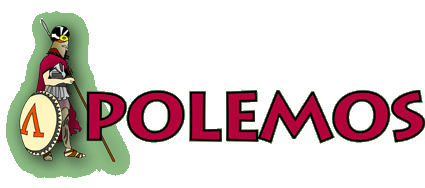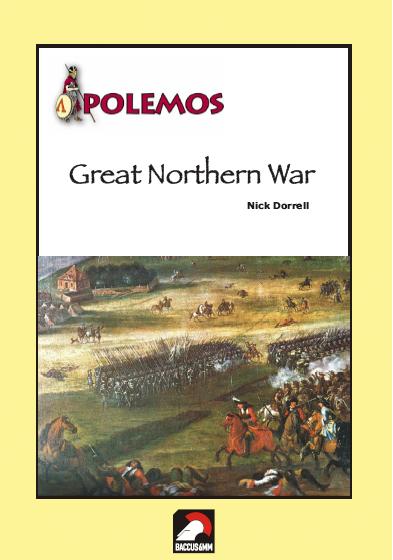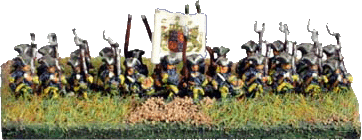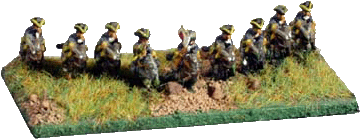
| Home | Painting Guide | Army Lists |
| Scenarios | Errata |
POLEMOS - GREAT NORTHERN WAR

POLEMOS GREAT NORTHERN WAR £15.00
The early years of the eighteenth century were a time of great, and long lasting, changes in Eastern Europe. It saw two former ‘Great’ powers decline; for Sweden it was a cataclysmic experience as they were reduced to a small or medium power. While Poland-Lithuania started on the path that would lead to extinction later in the century. It saw two medium sized powers, Denmark and Saxony, fail in their bid to gain, or regain, ‘Great’ powers status. It saw two powers rise; for Brandenburg-Prussia it was an important stepping stone to Great power status later in the century. While for Russia went from being ‘an obscure barbarous nation’ to a Great power thanks to its victories
.
Warfare in this area and period saw many competing tactical ideas. The latest tactics from Western Europe competing with traditional Eastern European tactics, as well as more recent local innovations. It saw stunning victories against the odds victories such as Narva in 1700, and catastrophic defeats such as Poltava in 1709. Battles came in many different varieties. Some were assault on fortified positions, some were assault river crossing, some were joint land – amphibious actions, etc.
Polemos: Great Northern War is aimed at gaming large scale actions from this time. It is quite possible to stage, play and complete actions in an evening and even the largest action should be relatively easy to play. The emphasis is on the Great Northern War but other actions from this period can also be fought. The wars against the Ottoman Empire, the Polish Civil War and other actions in the period 1695 to 1725 may also be fought. You can be Peter the Great of Russia and face the cream of what was probably the best army in the world of this period – Charles XII Swedish army. Perhaps instead you could as Peter battle the Ottomans on the river Prut.
The Great Northern War has perhaps not been gamed as much as would be expected for such an important conflict with many interesting battles and armies. To a large extent this is because of the lack of information about the war and its battles. Polemos: GNW will introduce information and army lists that will rectify this. You too will be able to command the combined Saxon, Polish and Russian army at the battle of Kalisz (1706) or re-fight the Polish civil war battle of Koniecpol (1708).
The basic playing piece in Polemos is the Base. An army is comprised of a number of Bases and can be built either using historical orders of battle or on Army Lists. Bases are grouped into Brigades of about 4 bases. Armies can vary in size from around 20 bases for smaller battles, to well over 100 bases for the very large battles.
Polemos:GNW is designed to allow the player to represent an army using a limited number of bases, each of which represents a tactical element that may act individually. Each base is designed to have enough figures on it to look like a real unit. The design focus eliminates fiddly lining up, precise numbers of figures etc in favour of a broader approach.
Unit Representation and Organisation
A single Base represents the smallest unit that contemporary generals, (who were, after all, in a position to know), thought worthwhile to deploy as a discrete formation on a battlefield. In the Great Northern War, these were:
-
A base of infantry, except skirmishing infantry, represents between 400 and 600 men. They can be a single battalion, a pair of smaller ones or a group of sub-units up to this approximate strength.
-

- A base of cavalry, dismounted dragoons and skirmishing infantry represents 2-3 squadrons or similar group, representing 200 to 300 men. A cavalry base is assumed to include wide intervals between squadrons, allowing friendly cavalry bases to pass through each other.
- An artillery base represents four to eight guns. The number of guns that a base represents varies depending on the size of the real guns. Four heavy guns will be represented by one base. While eight light guns will also be represented by one base.


In actual play the tactical
unit is the Brigade of about four bases. The Brigades are in turn organised
into Commands of 2 or more Brigades.

Ground
Scale and Basing
All distances in Polemos games are expressed in Base Widths (BW) and
Base Depths (BD) in order to aid the use of differing base sizes. A
BD is half a BW.
One base width (BW) represents 200 paces.
One base depth (BD) represents 100 paces.
This system means that any size can be used for bases, so no rebasing
is required providing both sides are consistent. We have found that
a 60mm x 30mm base gives the best results in both practical terms and
also in giving a good level of visual impact. All Baccus 6mm Polemos
Army and Booster packs are organised on this basis.
Using a BW of 60mm a table of 1.8 x 1.2 metres (6' x 4') represents
6000 x 4000 paces. As a rough guide this is the area of the main action
at Poltava, including the Russian camp and smaller redoubts.